Unlike motor vehicles, which are taken to various facilities for maintenance and repairs, or to petrol stations to refuel, spacecraft do not have such a luxury when some internal or external problems occur. To offset the occurrence of such problems, satellites must be built to the standard that they simply cannot fail during their anticipated lifetime, and they must also carry sufficient fuel for at least, and even beyond, a norm of 15 years of on orbit service.
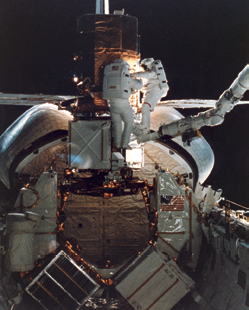
Mission Specialists George Nelson and James van Hoften repair the captured Solar Maximum Mission Satellite on April 11, 1984.
Suggestions have been made regarding the development of “repair shops” and “refueling stations” for these orbital vehicles. Such would extend a satellite’s operating life. Over the years, there have been numerous proposals and attempts to create such service vehicles.
In this article, some historic examples of satellite on orbit repairs will be offered, as well as an examination of proposals for future servicing operation vehicles.
The Perspective Of History
In the past, satellite repair efforts have been attempted on several occasions. On February 14, 1980, the Solar Maximum Mission (SMM) had been launched with a Delta 3910 launch vehicle. However, in November of that year, the satellite’s attitude control system failed. The problem was subsequently repaired, on orbit, by the crew of the STS-41C mission in April of 1984. On April 10, 1984, the satellite was captured by the Shuttle’s RMS arm. On the next day, Mission Specialists George Nelson and James Van Hoften completed an EVA of 7 hours, 7 minutes, during which time they replaced the Modular Attitude Control System and the Coronograph main electronics box of the SMM satellite. On April 12, 1984, SMM was released back into orbit.
The STS41B flight of February 3, 1984 placed two satellites, Westar-6 and Palapa-4, on orbit. Both satellites then suffered failures of their PAM-D upper stages, leaving them stranded in a Low Earth Orbit (LEO). While neither of the satellites were actually repaired “on orbit,” they were both retrieved by the STS-51A space shuttle flight and returned to Earth for repairs—the satellites were relaunched as Asiasat-1 and Palapa-6, respectively.
A slightly different approach was taken with the Syncom IV-3 communications satellite, placed into orbit by STS-51D on April 12, 1985. The satellite could not be placed into a geostationary orbit and it was repaired on August 31/September 1, 1998, by the crew of STS51I.
The best known rehabilitation mission as of this writing was the Hubble Space Telescope, which had been placed on orbit by STS-31 on April 24, 1990. Once the spatial observatory was operational, the discovery was made that the main telescope mirror provided fuzzy images due to a spherical aberration of the primary mirror. Seemingly, the mirrors had never been tested prior to incorporation into the satellite. As a consequence, the Wide Field Camera could not be used and the Faint Object Camera could only produce inferior pictures.
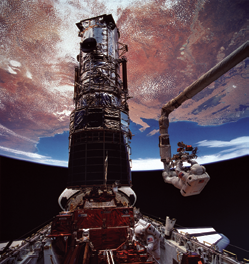
Astronauts Story + Musgrave work on Hubble in the Endeavour’s payload bay.
NASA awarded a contract for the construction of the Corrective Optics Space Telescope Axial Replacement (COSTAR) that was installed during a service mission conducted by STS61. After having been captured and placed in the payload bay of the Space Shuttle on December 4, 1993, the astronauts, during five EVA’s, installed COSTAR and also replaced other Hubble components. After having been in the Shuttle’s payload bay for 145 hours and 1 minute, the telescope was released.
Subsequent service missions to the telescope were conducted from February 13th to the 19th in 1997 (STS-82); December 21st to 25th in 1999 (STS-103), March 3rd through 9th in 2002 (STS-109); and May 13th to 19th in 2009 (STS-125). These missions provided updates to the Hubble’s systems and instruments.
The common factor of the “repair” mission described above was the use of the Space Shuttle and the involvement of astronauts during EVA’s. With the Shuttle no longer available for such work, attention has now focused in on automated or robotic facilities.
DART
Among such operations was the Demonstration of Autonomous Rendez Vous (DART) satellite that was launched on April 15, 2005, via a Pegasus XL launch vehicle as part of a test program conducted by NASA for studies leading to the Orbital Space Plane (OSP) program for a second generation Space Shuttle.
The DART was built by Orbital Sciences and the 350kg satellite was to demonstrate technologies to locate and maneuver near an orbiting satellite using an on-board computer. DART was programmed to approach the MULBLCOM satellite, which was launched on May 18, 1999, several times on April 16, 2005. However, the fuel for the DART’s nitrogen thrusters ran out when the satellite was about 100m from the target satellite and the approaches were abandoned. The two satellites did, however, make physical contact, which pushed MUBLCOM into a higher orbit. It is not believed that either satellite was damaged.
Proposals
There are various proposals for on orbit repair and refueling spacecraft currently under development.
SIS
In 2011, Intelsat and MacDonald, Dettwiler and Associates Ltd. (MDA) entered into an agreement for MDA to service Intelsat on orbit satellites using MDA’s proposed Space Infrastructure Servicing (SIS) vehicle. SIS was to service satellites in need of additional fuel, re-positioning or engaging in other maintenance while using a sophisticated robotics and docking system. A robotic arm would be used for refueling and could also be used to perform maintenance and repair tasks. The first launch was expected to take place in 2015. However, this project was canceled in January of 2012 as there was a lack of interest from Intelsat, other commercial firms as well as the U.S. Government.
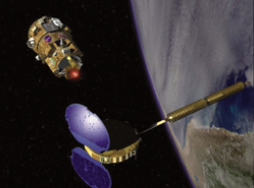
Artistic rendition of DART.
DEOS
The Deutsche Orbitale Servicing Mission (DEOS) is a proposal from the German space agency DLR for a two satellite system to demonstrate the performance of on orbit maintenance tasks, in particular refueling, that will extend the service life of satellites. The test will consist of two satellites, a “client” and a “servicer.” The satellites will be built by Airbus Space and Defense and will be launched in 2018. At launch, the two stacked spacecraft will be placed into a near polar orbit of between 400 and 600km altitude. Following separation, the satellites will undertake a number of increasingly complex experiments. These will include the capture of a tumbling, non-cooperative client satellite with a servicer spacecraft as well as the de-orbiting of the coupled configuration in a pre-defined corridor at the end of mission.
MIT Fuels Another Idea
Recently, an engineering team at the Massachusetts Institute of Technology (MIT) advanced the idea that future lunar mission could be fueled through a propellant depot somewhere on orbit between the Earth and the Moon. It was argued that this would reduce the amount of fuel that would be needed to be carried during spacecraft launch, allowing for heavier payloads.
Rather than focusing on sending “tankers” into space to refill orbiting depots, this study advanced the idea that the unused “contingency” fuel carried by lunar spacecraft in case of emergency situations be deposited at these spatial fuel depots prior to the lunar spacecraft’s return to Earth. This fuel can then be collected by the next mission as the craft’s contingency fuel. If not used, the fuel can be returned to the depot. Alternatively, quantities of contingency fuel can be stockpiled in the depot over a period of time and used, at a future date, by a large cargo mission to the Moon as its primary fuel source.
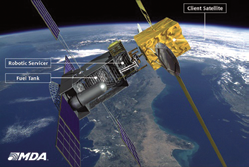
Artistic rendition of SIS, courtesy of MDA.
Robonaut
While the current experiments with the Robonaut on the International Space Station are clearly related to the operation of the ISS, the experience with this robotic device, permanently located at the Space Station, may have long term influence of the discipline of satellite repairs on orbit. In such a scenario, a “descendant” of the current Robonaut would fly to an ailing satellite and provide an on orbit repair.
In a similar way, the current efforts by NASA in developing robotic refueling techniques through the demonstrations of the Robotic Refueling Mission (RRM) on the International Space Station in January 2013, and the follow-on ground-based Remote Robotic Oxidizer Transfer Test (RROxiTT), may, eventually see wider applications.
The RRM demonstrations were made with Dextre, the twin-armed Canadian robotic handyman, using four unique RRM tools and an RRM module containing satellite piece parts and refueling components. While the RRM tests used ethanol as a substitute for the more volatile satellite fuels, RROxiTT will test the transfer as oxidizers. In particular, nitrogen tetroxide (N2O4 or NOX) will be used to test how robots can transfer such oxidizers at flight-like pressures and flow rates, through the propellant valve and into the mock tank of a satellite that was originally not designed to be serviced in space.
ViviSat
Calling the effort “satellite life extension,” the ViviSat project is claimed, once established, to be able to provide in-orbit satellite life extension and protection services. These will range from significantly extending a satellite’s mission length, engagement into new markets, and will also drive asset value as well as protect franchises. U.S. Space and ATK Space Systems created ViviSat to provide satellite mission length extensions with flexible, scalable, capital-efficient, and low risk services. U.S. Space will be the operating entity, while ATK Space Systems will build the ViviSat as well as the launch and ground segments.
ViviSat uses a Mission Extension Vehicle (MEV) that will safely connect to an orbiting satellite. This maneuver will provide supplemental attitude and propulsive capabilities without client satellite operational disruption—quite a plus. The MEV uses a space-ready docking system and a suite of integrated proximity sensors to securely rendezvous with the host satellite. The U.S. Space company’s tagline seems to be highly appropriate, should this project fall into place—“Revitalizing Your Space Assets.”
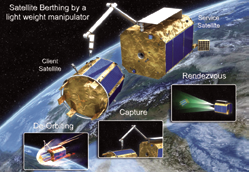
Artistic rendition of DEOS operations. Image courtesy of DLR.
Is The Cost Worth The Effort?
The establishment of on orbit spacecraft servicing and refueling facilities is ultimately dependent on the cost—or rather, the savings—that can be made. And herein lies the biggest problem: Are these endeavors worth the effort?
In this context, it is appropriate to consider that the repair services provided with the Space Shuttle were not primary missions (with the exception of the Hubble related mission). While there was obviously a cost involved, it did not involve the cost of a special launch. The exception to this was the STS-61 Hubble servicing mission. In that case, it was, however, a choice between the extra costs of an STS launch and the abandonment of the Hubble Space Telescope.
Future Considerations
As far as future scenarios are concerned, and in broad terms, the choice seems to be between a dedicated servicing mission for a single spacecraft in trouble and an orbital “repair shop,” the latter fitted with the necessary spare parts for an operation life of, say, 10 years. The obvious cost in both scenarios is the build of the launch vehicle to place the repair facility on orbit. In the case of the orbital “repair shop,” there is the additional cost of re-stocking the repair facility with additional spare parts.

Artistic rendition of ViviSat’s MEV.
A single spacecraft servicing mission’s cost is not complex and will follow the same considerations as the STS-61/Hubble mission, referred to earlier in this article. However, in the case of a permanent orbiting repair shop, the range of spares to be carried must be considered. This is relatively simple in the case of communications satellites that carry fairly standard transponders and other components. However, it would be less clear for other satellite genres. Additionally, there is the cost associated with launching and then maneuvering of the two spacecraft to rendezvous in space at probably totally different orbits.
Furthermore, another consideration should be the frequency of breakdowns during the operational life time of an orbital repair shop.
Finally, and this is perhaps the most overriding argument against an orbital repair shop, is the obsolescence of parts—for example, satellite technology developed ten years ago is now totally out of date and unusable.
In the case of on orbit refueling, the biggest problem to be considered is that of sending fuel up into orbit at a cost, whether it is with the original spacecraft or during a subsequent refueling mission. In this context, the MIT proposal discussed above is interesting in that it makes use of spare fuel that is already on orbit.
All these cost-benefit pros and cons should not stop scientists and engineers from developing and experimenting with on orbit repair and refueling techniques.
The knowledge gained from these efforts will be essential in case lunar bases are established or, for instance, if new sources of energy resident in space can be harnessed.

About the author
Jos Heyman is the Managing Director of Tiros Space Information, a Western Australian consultancy specializing in the dissemination of information on the scientific exploration and commercial application of space for use by educational as well as commercial organizations. An accountant by profession, Jos is the editor of the TSI News Bulletin and is also a regular contributor to the British Interplanetary Society’s Spaceflight journal. For further information, please visit http://tiros.zarya.info


